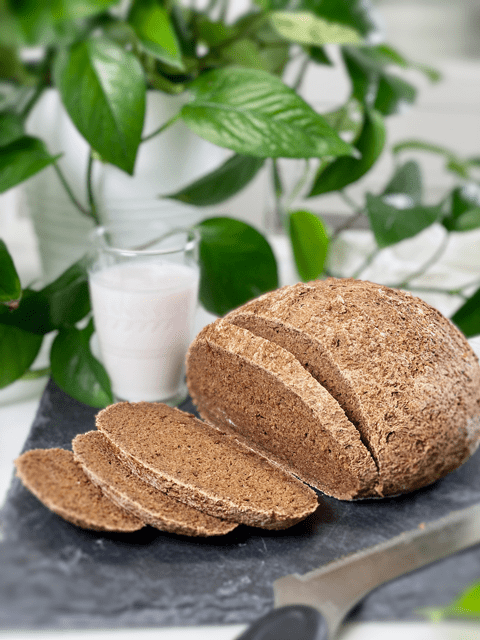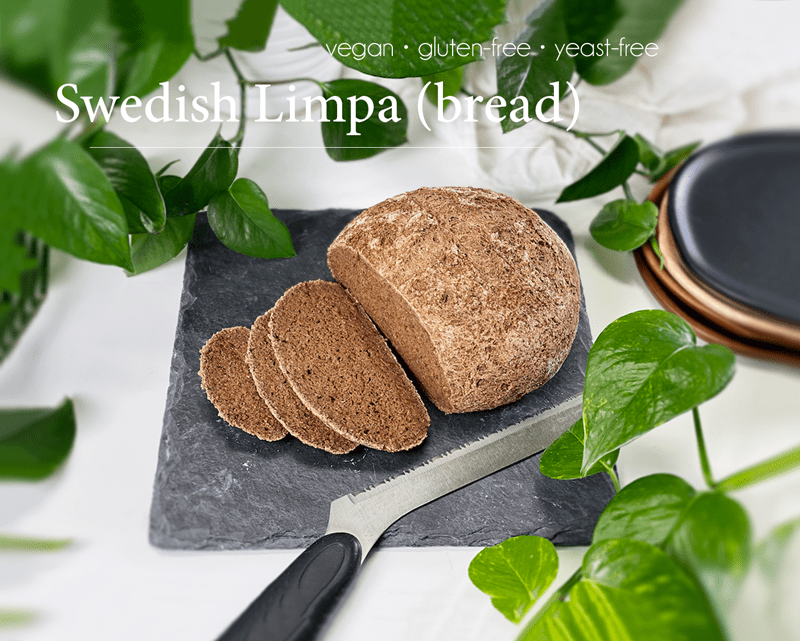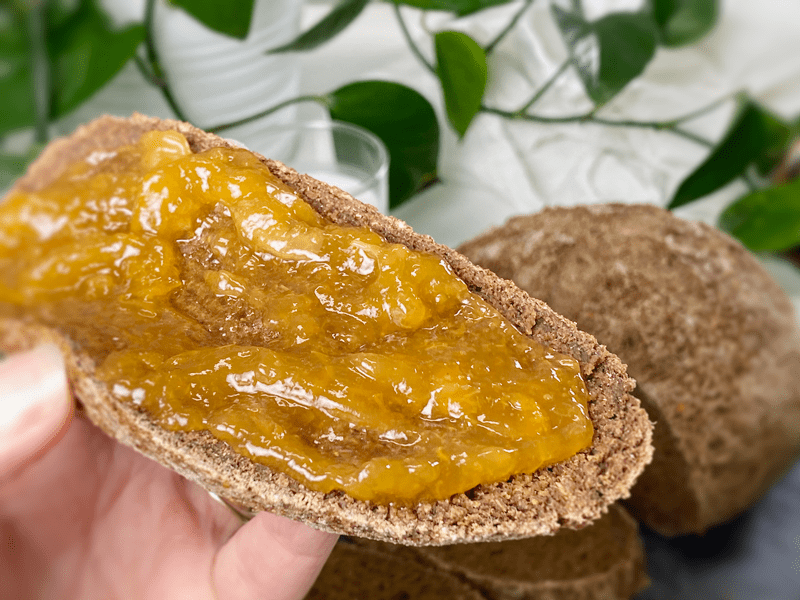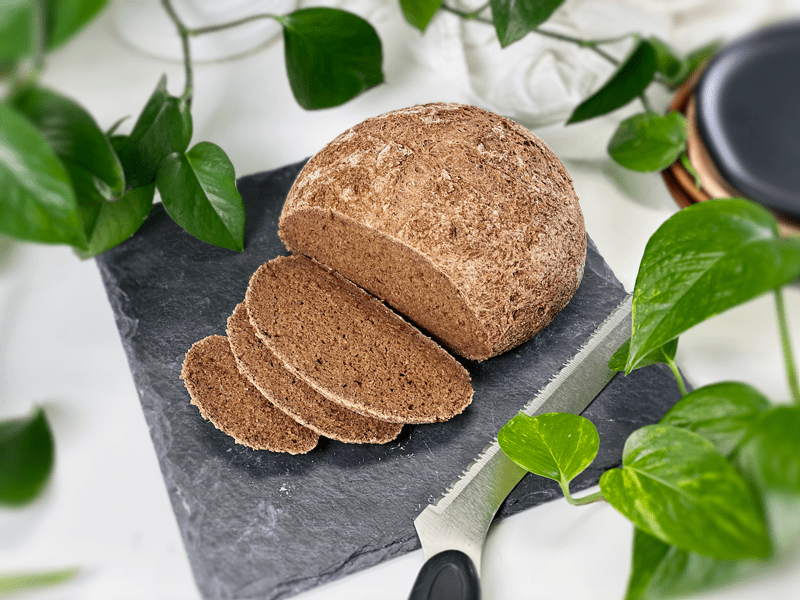


 Add to favorites
Add to favorites
Limpa bread is a sweet Scandinavian rye bread associated with Swedish cuisine. Today I presenting a loose interpretation of my take on it. Traditionally, it is an anise-flavored rye bread that is made up of rye, anise seed, molasses, and some have been known to add the zest of orange. The word limpa means “loaf” in Swedish, and it makes a great accompaniment to soups, a delicious sandwich base, and is excellent toasted.

Over the past few years, I have been trying to tap into my Scandinavian heritage, which makes up 38.9% of my ancestry. I have always been drawn to Norway, Sweden, Denmark, and Iceland but have yet to excel in that general direction, so until then, I will start in my very own kitchen.
In my research, I have learned that there are four grain types that dominate the Nordic countries: barley and rye are the oldest; wheat and oats are more recent. I realize that my bread ingredients will be a bit unconventional. So, if you are of Swedish heritage, please know that my goal for this recipe was to achieve the texture and flavor of Swedish limpa without compromising our health goals. So, if you can set aside the idea of not using traditional ingredients and wish to try your hand at making Swedish limpa with me — tighten up that apron and meet me in the kitchen!

Quick side story — My first attempt at this bread was a DUD! I mean a REAL dud. It didn’t rise, it was heavy like a brick, and it had a funky taste. I figured out the undesirable texture… I tested out a different gluten-free flour blend (should have known to stick to my tried and true blend), but the odd flavor and lack of loft stumped me.
Undefeated, I set out to make another loaf. When I got to the part of measuring out the baking powder, for some unknown reason, I lifted it to my nose to smell it. I smell most of my ingredients but NEVER baking soda (it doesn’t smell) but this one did and it was of garlic??? Earlier in the week Bob was cooking and used garlic powder, onion powder, and baking soda. Normally, he chases me down to smell the jars before he screws the lids back on (since he can’t smell), but this time around, he got distracted, twisted the lids on, and put them back in the spice drawer. As you can guess, the lids on the garlic powder and baking power got swapped. Mystery solved!

When I shared the story with Bob, we both chuckled because it reminded us of another incident that happened a handful of years back when I put the wrong fuel in our Volkswagen Bug. Bob typically drives whenever we motor about but this particular day, I decided to drive. On the way home, I swung into the gas station to fill the gas tank. I put jumped out of the car, removed the gas cap, jammed the nozzle in, and hit the lever. Fuel was pumping in at lightning speed.
As the tank was filling, I motioned for Bob to roll his window down. I asked him, “This car takes regular, right?” He laughed, looked at me sideways, and then looked panic. “Ahh, NO, it takes diesel! You didn’t put…” I quickly cut him off, “I DID! I DID put regular gas in the tank!” We had to tow the car home where Bob and my Uncle Lonnie tore the car apart to drain the gas tank, the fuel lines, and so forth. As soon as they reassembled the car, Bob told me to run it down to the gas station to put DIESEL in it. I have never been so nervous in my life.
So, what MADE me think to smell the jar of baking soda? I’ve never done that before. What MADE me think to question the fuel that I was putting in the car?! I’ve never done that before. I am so thankful that Bob and I operate in grace and ease when it comes to making mistakes in life. We have learned to laugh a lot throughout our marriage; getting mad just never made sense.
The texture, appearance, and flavor of this bread are spot on (according to my taste buds), despite not being made with traditional ingredients or technique. It is a rich, brown color, hearty, springy, and loosely dense. It has a deep “rye” flavor, a flavor of the earth, and one full of character. And let’s not forget about the orange zest… just enough was added to kick in as a lovely aftertaste… giving you that Swedish bread shop experience.
Don’t allow the intoxicating aroma of freshly baked bread to entice you to cut the bread too soon after removing it from the oven. The loaf needs to cool at least 30 minutes, and ideally more like up to two hours. When you pull the bread out of the oven, it is still baking inside. Cutting into a loaf too early will stop this process and result in a very gummy loaf.
I hope I didn’t bend your ear too long on this post. It was fun to reminisce. If you find yourself adventurous and you make this bread, please be sure to leave a comment below. I want to give a special thank you to Juanita, who inspired me to make this bread in one of our Facebook group postings. blessings, amie sue
 Ingredients
IngredientsYields one loaf
Psyllium Gel
Main Bread Ingredients
Psyllium Gel
Dry Ingredients
Mixing and Baking the Dough
Dutch Oven Method (if using)
Storage
Hi Amie Sue,
This bread looks delicious and I would love to make it. However, I only have in the house psyllium husks and flakes but not powder. Is the difference big enough to affect the taste if I use those two kinds only? What about the quantity? Do you think I should try to make into powder the husks? Or flakes? Thank you.
I lol at your stories. I did it too once using cinnamon instead of paprika. Laughing at yourself is the best laugh. 🥰😂 Many thanks for all these warming heart recipes and their originality.❤️❤️❤️
Oops, I realized I missed the word “or” in your recipe, Amie Sue. Now I have the answers to my first message.
I will let you know how my limpa turned out 🥰
Hugs and many thanks,
Good day GG… no worries, I am glad you found your answer before I had a chance to respond. :) I hope you enjoy the recipe and please be sure to let me know. blessings, amie sue
Good afternoon, Amie Sue &
Happy St Patrick’s Day!
For baking the bread on a sheet, what temp should the oven be – 350?
Thank You,
Cogoudo
Good day, Cogoudo,
Happy St. Patrick’s Day to you too. :) The baking temperature is 350 degrees (F), regardless of what type of pan you use. I adjusted it so it was more clear. Enjoy and have a blessed day, amie sue
Hi Amie Sue, again,
I still did not make the LIMPA as I need a couple of more ingredients.
I was wondering if you soaked and dehydrated the buckwheat before you used it in the bread or maybe it would not make a big difference health or taste wise for a 1/2 cup.
I got a whole package of organic, raw buckwheat, and I am not sure if I should soak the whole thing and dehydrate before I start using it.
Advise please! Many thanks
Good evening GG,
As far as the buckwheat goes… you can use it either way. For better digestion and absorption of nutrients, I recommend soaking and dehydrating them first. I am in such a habit of presoaking/dehydrating all my nuts and seeds so they are ready for recipe making. If you don’t have time to do it, you can skip that step. I hope this helps. blessings, amie sue
After reading most of your buckwheat posts, I realized that this is what I should have done.
Thank you for confirming it.
Hugs and blessings of health to you & Bob!
Hi Amie Sue,
I can hardly wait to get home and try this! And I’m thrilled that I could inspire you to make this recipe for us! My mouth is watering just remembering the bread from the little bakery in Milaca, MN where we bought and enjoyed it! My grandfather—my mom’s dad—was Swedish and my grandmother Norwegian, so we had tastes here and there of different Scandinavian foods. The limpa was the most deliciously memorable!
Hugs,
Juanita
Good day Juanita,
Oh, I sure do hope that it lives up to your memory :) I have a lot of family from MN as well with the same background. Thanks so much for sharing. hugs, amie sue
Amie Sue – This recipe is genius! Thank you for putting so much time into creating recipes that are healing and delicious! I truly appreciate that you include the metric measurements because I just started following it in recipes that include metric instead of the US customary system and realize how much of a difference it makes in how the recipe turns out. :) Joanie
Good day Joanie,
Thank you so much for the positive feedback. I truly appreciate it! I have been working more and more on adding weight measurements, especially on the bread recipes. It makes a big difference. :) I hope you enjoy the recipe. Keep me/us posted. Have a blessed and happy day, amie sue
Oh my, I have never heard of Limpa bread. The use of dried seeds are very intriguing. I would need to get those and try making this bread! Thank you Amie-Sue and God bless you!
You are so welcome Schlomit. I loved rye bread back in the day when I ate gluten… so creating this recipe brought back an ole’ favorite and one that is much healthier for me. Enjoy! amie sue
I have made this bread today and very happy with the result. I didn’t have a stand mixer so I kneaded the dough by hand using a wide rubber spatula using a fold and tuck motion. This is my first time eating Limpa bread and the taste was very intriguing. I will make this again. Thank you for sharing this recipe Amie-Sue
Thank you so much for the feedback Shlomit. You are going to get some strong arm muscles. hehe blessings, amie sue